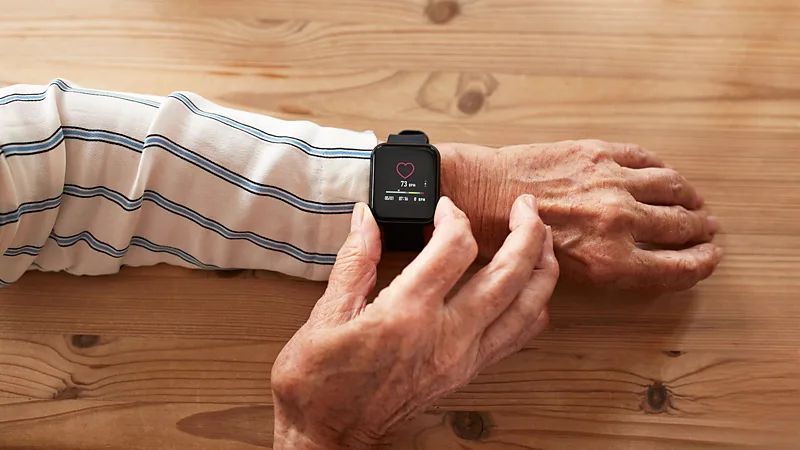
Smartwatches That Predict Parkinson’s Disease
Smartwatches are collecting vast amounts of physiological data, and their technology is being utilized in innovative ways.
Dr Patrick Schoettker, a chief anaesthesiologist at CHUV University Hospital, understands the complications that can arise from lengthy surgeries involving general anaesthesia. Rapid blood loss during surgery can lead to shock, causing dangerous drops in blood flow. Additionally, severe lung problems can develop after extended sedation, which is responsible for a quarter of deaths in the first six days following surgery.
These tragedies sometimes stem from unnoticed physiological issues. What if hospitals could quickly and affordably screen for such risks before major procedures?

Schoettker and his team are trialling a smartwatch called the Masimo W1, which patients wear for weeks before their pre-operation consultation. The data collected helps assess their health status.
The W1 continuously monitors heart rate, respiration rate, blood oxygen levels, pulse rate, and hydration, all with medical-grade accuracy. Schoettker likens this data to a “digital twin,” believing it could save lives. “We plan to use this pre-operative data to predict possible complications and take preventative action,” he explains.
This is just one example of how the booming smartwatch market—projected to exceed 400 million devices sold worldwide by 2027—is paving the way for preventative health measures. Companies like Masimo, Apple, Samsung, Withings, Fitbit, and Polar have developed smartwatches that can track sleep quality, blood pressure, heart rhythm variations, and blood oxygen saturation in real time.
Dr Gosia Wamil, a consultant cardiologist at Mayo Clinic Healthcare in London, notes that this data is helping doctors detect potential health issues earlier. “More patients are eager to use their smartwatches to gather data and share results with us,” she says, allowing for further investigation into any abnormalities.
Heart health has seen significant advancements thanks to smartwatch data. A study published in April found that smartwatch ECG measurements could reliably identify extra heartbeats in healthy individuals aged 50 to 70, a potential warning sign for atrial fibrillation, where the heart beats irregularly or rapidly.
Moreover, AI algorithms have demonstrated that Apple Watch ECG readings can identify individuals with low ejection fractions—an indicator of heart failure—with 88% accuracy. Wamil believes that combining machine learning with smartwatch data could revolutionize care for various heart conditions.
“In cardiology, patients often report palpitations, and we used to rely on 24-hour ECG recordings,” Wamil explains. “Now, with smartwatches, patients can press a button when they feel symptoms, capture an ECG, and present it to us.”

This advancement leads to proactive treatments, such as prescribing blood thinners to patients showing irregular heartbeat signs, helping to prevent strokes. Wamil is also investigating whether this data can alert doctors and patients about cardiovascular risks for individuals with type 2 diabetes.
However, the applications of smartwatches extend beyond heart health. A July 2023 study from Cardiff University demonstrated that smartwatch data from over 100,000 participants could identify early signs of Parkinson’s disease up to seven years before a formal diagnosis by detecting subtle changes in walking patterns.
Cynthia Sandor, who led the study, believes combining motion data with other smartwatch metrics, like sleep quality—which is often disrupted in those with Parkinson’s—could enhance early detection. “In Parkinson’s, there is a phase where signs such as motor changes appear,” Sandor states. “We found that slowing movement during light activity was the most predictive feature.”
This early detection could help recruit individuals for clinical trials. It’s suggested that diagnosing Parkinson’s too late hinders effective treatment, and early screening tools using smartwatch data might facilitate successful neuroprotective trials.
Researchers are also optimistic about smartwatches aiding those with chronic conditions like epilepsy by providing early warning signs for seizures, which pose risks of falls and injuries. Aileen McGonigal from the Queensland Brain Institute is testing a prototype smartwatch designed for research to predict seizures by analyzing various data streams, including heart rate variability and skin temperature.
While excitement surrounds the potential of AI-driven smartwatch data, some doctors express caution about the risk of false positives. They warn that excessive use of smartwatches might increase patient anxiety and strain healthcare systems.

“Technology is benefiting medicine in many ways, including early problem detection that can save lives,” says Jeremy Smelt, a consultant thoracic surgeon at St George’s Hospital NHS Foundation Trust. “However, false positives can lead to unnecessary anxiety and visits to GPs. Still, for patients with health conditions, smartwatches could save money by catching issues early.”
As smartwatch technology advances and manufacturers discover more ways to gather quantifiable health data, the list of potential preventative health applications will continue to grow.
Masimo CEO Joe Kiani is already focusing on predicting asthma attacks with their smartwatches. “We can measure respiratory effort,” Kiani explains. “We can identify when a person is struggling to breathe as their respiration and pulse rates increase due to lack of oxygen. For decades, our only home measurement was a thermometer; now we have a wealth of information that can help people avoid emergency visits while still receiving appropriate care.”





